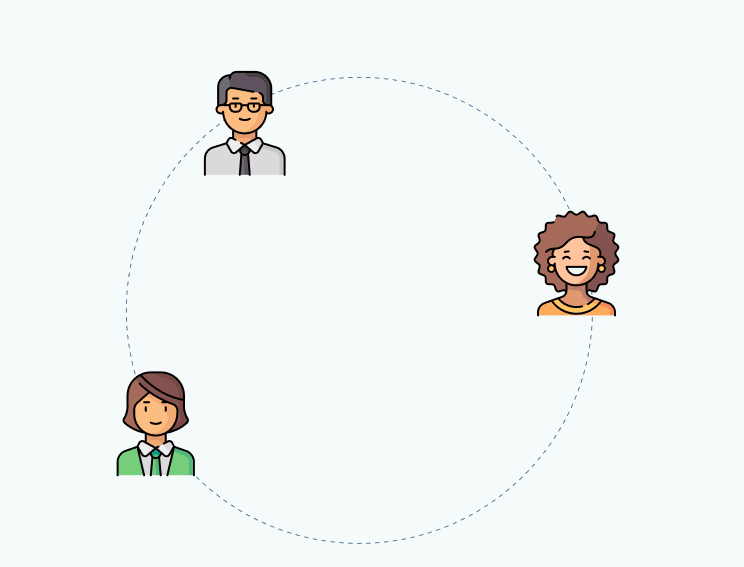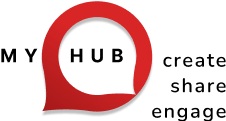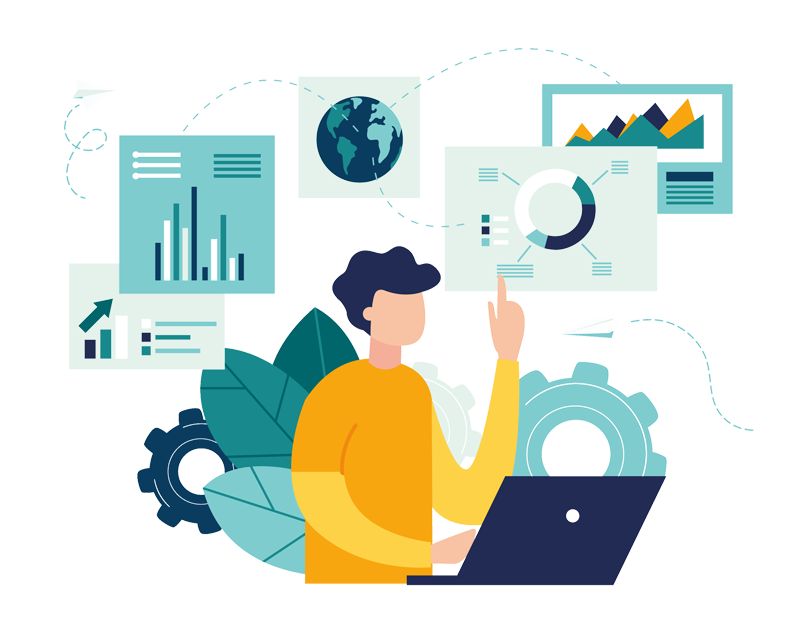
Your New Intranet Starts Here
Streamline communication, boost collaboration, and empower your team with MyHub's intuitive intranet solution.
Book a live demo now and experience the difference.
Take a Quick TourRichard Branson famously said that customers come second and employees first. And he’s right – putting your employees first leads to significant benefits for both your organization and your clients. Happy, engaged employees are more loyal, more productive, and deliver superior customer service. In other words, investing in employees is not just a feel-good move – it’s smart business strategy.
Today’s forward-thinking companies are adopting a much broader and more strategic approach to employee development than ever before. Rather than focusing solely on traditional training programs, they’re embracing holistic strategies that support employees’ physical, emotional, and intellectual well-being.
If you want to attract and retain top talent, overcome skill shortages, and ensure critical organizational knowledge is retained and shared, you need an approach to staff development that goes beyond the basics. In this guide, we’ll explore why implementing employee development strategies are one of the best investments your business can make – and how to maximize its benefits through innovative strategies and planning.
Why Now? The Urgency of Employee Development
In today’s competitive job market, employee development has never been more essential. Recruitment and retention challenges are putting pressure on organizations across industries. One of the most effective ways to turn the tide is to invest in your human capital. But this isn’t just about training courses – it’s about future-proofing your business.
As Amazon’s Jeff Bezos once said: “In business, what’s dangerous is not to evolve.” That evolution begins with your people. When you commit to their growth, your organization evolves with them.
In this post, we define what employee development really means, outline the key benefits, and walk you through how to build an effective employee development plan in five practical steps.
Let’s start with a definition.
What Is Employee Development?
Employee development is the continuous process of enhancing an employee’s skills, knowledge, and competencies to support their career growth and help achieve organizational goals. It’s not a one-off event, but rather an ongoing commitment to learning and improvement – benefiting both employees and the business as a whole.
What Are Examples Of Employee Development?
Professional development can take many forms. These include:
- On-the-job training and upskilling programs
- Mentoring and coaching relationships
- Attending industry conferences and webinars
- Enrolling in university or vocational courses
- Participating in immersive learning using AR or VR simulations
While each employee is ultimately responsible for their own career path, smart companies actively support and encourage growth. By offering a wide range of learning and development opportunities, businesses benefit from more knowledgeable, adaptable, and confident team members.
But the advantages go far beyond better individual performance. Let’s look at the wider business impact.
Why Is Employee Development So Important?
Implementing strong employee development strategies offers a wide array of business benefits:
- Increase employee retention – Staff who feel supported are less likely to leave.
- Attract top talent – Development opportunities are a key driver for job seekers.
- Improve employee engagement – Learning fosters commitment and motivation.
- Enhance team performance – Skilled employees contribute more effectively.
- Boost innovation and adaptability – Ongoing learning fosters a growth mindset.
The bottom line? Employee development is a catalyst for business growth. When your people feel valued and empowered, they’re more invested in your company’s success – and more likely to stick around for the long haul. That’s a win for your culture, your brand, and your bottom line.
The Importance Of Employee Development
Quite simply, your employees are your most valuable asset. Investing in their growth is not just a perk – it’s a strategic imperative. Below are five compelling reasons why every business should prioritize staff development as a core part of its success strategy.
1. Attract And Retain Top Talent
Employee development strategies play a crucial role in attracting high-caliber candidates and retaining them over the long term. In today’s competitive job market, a comprehensive program of learning and growth opportunities sets your business apart. Candidates actively seek out employers who are committed to professional growth, and your reputation in this area can directly impact your ability to recruit.
According to Forbes, 86% of employees would switch jobs if offered more development opportunities. Furthermore, employees who see their long-term goals being supported by their employer are far more likely to stay loyal and engaged.
2. Strengthen Succession Planning
With the baby boomer generation retiring in large numbers, many companies face a leadership vacuum. Those best positioned to navigate this change are organizations that have proactively invested in internal talent development.
By preparing your current workforce for future leadership roles, you create a solid pipeline of promotable, well-prepared employees. Effective succession planning ensures business continuity and mitigates risk associated with sudden vacancies in key roles.
3. Boost Employee Engagement and Motivation
Employees who feel appreciated and invested in are more likely to be engaged and productive. Research cited on MyHub Intranet shows that companies with engaged teams report 22% higher profitability.
Implementing a thoughtful employee development program sends a clear message: your people matter. This sense of value boosts morale, enhances loyalty, and helps create a vibrant, purpose-driven workplace culture where employees thrive.
4. Reduce Hiring Costs And Save Time
It’s significantly more cost-effective to train and promote from within than to hire externally. According to a report by the Society for Human Resource Management, the average cost of hiring a new employee is $4,129, and it typically takes 42 days to fill a role.
In contrast, investing in internal development accelerates readiness and eliminates many onboarding challenges. Upskilling existing staff minimizes disruptions, increases productivity, and relieves pressure on teams who might otherwise carry the extra workload during transitions.
5. Futureproof Your Business
Industries are evolving rapidly due to technological advances, economic shifts, and global trends. A workforce that’s continuously learning is better equipped to adapt, innovate, and compete.
Futureproofing your business means cultivating a culture where curiosity, creativity, and adaptability are nurtured. A strong employee development program keeps your team ahead of the curve and helps your organization stay relevant in an ever-changing landscape.
Taking A Modern Approach To Employee Development Strategies
Now that we’ve established the strong business case for investing in your people, the next step is understanding how to do it effectively. Businesses that lead the way in talent management are those that take a holistic view of employee growth.
Rather than focusing only on technical skills or mandatory training, these organizations implement development programs that address the physical, emotional, and intellectual needs of their workforce. If you want your strategy to deliver its full potential, it’s worth incorporating fresh, innovative ideas into your approach.
Effective Approaches To Employee Development
Prioritizing Employee Wellness
Forward-thinking companies understand that employee development goes beyond training and skill-building. A truly holistic approach must include employee wellness as a core component. According to the CDC Foundation, absenteeism costs U.S. employers a staggering $225.8 billion annually. Given this, prioritizing employee wellness is not only compassionate – it’s a smart business investment.
But what does an effective employee wellness program actually look like? For some businesses, it begins with providing information on workplace ergonomics, occupational health, and lifestyle advice – including guidance on eye health, diet, and fitness. Others go further with on-site fitness classes, yoga sessions, or running clubs. Additional initiatives may include subsidized gym memberships, access to healthcare professionals, or even comprehensive employee benefits that include mental health services and financial wellness programs.
The shape and scope of your wellness program may depend on budget, but even low-cost initiatives can significantly reduce sick leave and improve overall productivity. A Gallup survey found that 44% of employees experience burnout at work. Another report revealed that 80% struggle with poor work-life balance. Clearly, addressing wellness can drive engagement, reduce errors, and improve safety.
Encouraging Mindfulness In The Workplace
Mindfulness has gained traction in modern workplaces as a tool to boost focus, resilience, and emotional wellbeing. Global giants like Google and Nike are championing this trend, integrating mindfulness techniques into their company culture.
It’s time to rethink mindfulness beyond yoga and incense. A simple yet powerful step is creating a quiet room or dedicated reflection space in the office. Here, employees can take a mental break, meditate, or escape from the digital noise of constant emails and notifications.
More proactive organizations use structured mindfulness practices such as group breathing exercises. Just a few minutes of controlled breathing each morning helps employees recover from commute-related stress and approach the day with clarity.
Another impactful habit is gratitude journaling. Encouraging staff to note down daily accomplishments or moments of positivity – be it a successful meeting, team collaboration, or personal breakthrough – fosters a more optimistic mindset. Over time, these records build a tangible sense of progress and strengthen company morale.
Using a Variety of Learning Tools
At the heart of all employee development strategies is the effective transfer of knowledge and skills. But with diverse personalities and learning styles in every organization, a one-size-fits-all approach simply doesn’t cut it anymore.
Some employees are visual learners who thrive on diagrams, videos, and infographics. Others are auditory learners who absorb knowledge better through podcasts or lectures. Reading/writing learners prefer manuals, guides, and checklists, while kinesthetic learners flourish with hands-on activities like role-playing or shadowing a mentor.
The most successful organizations embrace this diversity by offering a blended learning environment. This might include webinars, microlearning platforms, collaborative wikis, and hands-on training exercises. By doing so, companies ensure that all employees, regardless of learning preference, are empowered to grow.
Importantly, online learning tools offer flexibility – employees can access materials at their own pace and revisit content as needed, making learning both accessible and effective beyond the confines of traditional 9-to-5 schedules.
Enabling Personalized Development Plans
Gone are the days when professional development was limited to a couple of pre-approved courses. Leading organizations now focus on personalized, employee-led development, where individuals chart their own growth paths.
In this model, employees receive a professional development budget and are encouraged to select learning opportunities that align with both personal interests and company goals. Whether it’s a certification course, conference, or online workshop, the only requirement is that the training adds measurable value to the organization.
This approach boosts motivation and engagement by giving staff ownership of their learning. It also frees up management time and aligns individual ambition with broader company success.
Top Methods for Successful Employee Development
The business case for investing in employee development is crystal clear. As Doug Conant, former CEO of Campbell’s Soup, aptly said:
“To win in the marketplace, you must first win in the workplace.”
Creating a comprehensive, modern development program is not just about professional training – it’s about fostering a culture of continuous improvement, resilience, and wellbeing. Incorporating wellness, mindfulness, diverse learning tools, and personalized growth plans can significantly enhance employee satisfaction, performance, and retention.
Boost Your Employee Development Strategy With MyHub Intranet
Looking to streamline and scale your employee development efforts? The MyHub Intranet provides ready-to-use intranet templates that support everything from knowledge transfer and onboarding to training and engagement.
Our platform makes it easy to foster a culture of development while enhancing productivity and collaboration. Contact us today for a free demo or sign up for a no-obligation 14-day trial – no credit card required.
FAQ
What is employee development, and why does it matter?
Employee development involves ongoing efforts to improve skills, knowledge, and performance. It boosts engagement, productivity, and long-term retention.
How can businesses support employee wellness in development programs?
Companies can include wellness initiatives like fitness classes, mental health resources, and mindfulness sessions to support holistic growth.
What are some modern methods of employee training?
Innovative approaches include microlearning, AR/VR simulations, webinars, coaching, and self-directed online courses.



